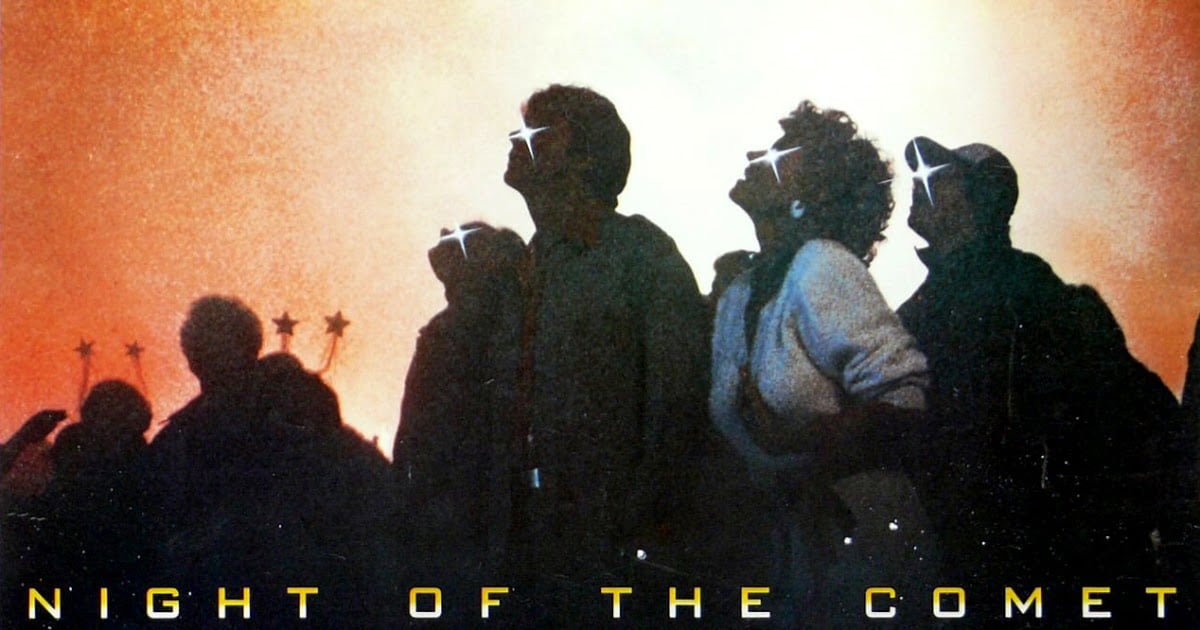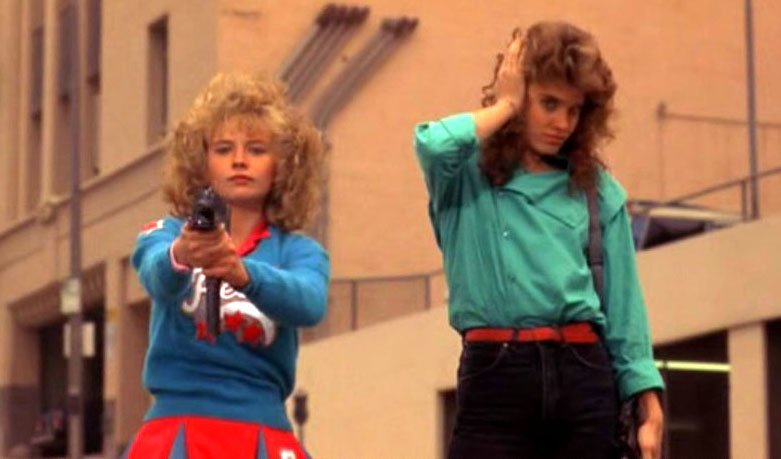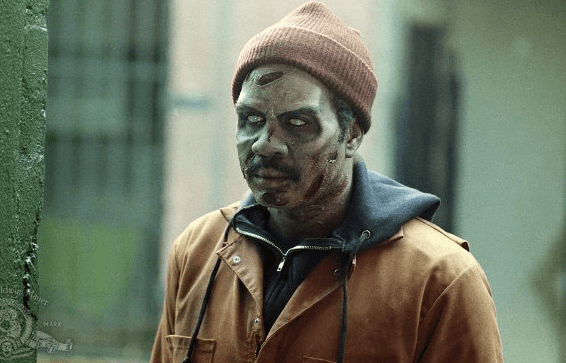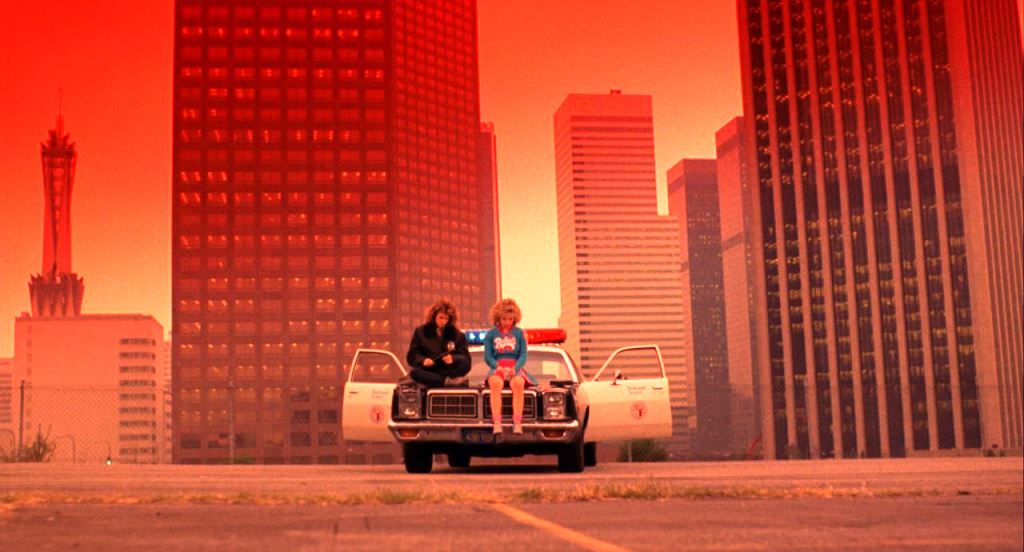
‘Night of the Comet’ is a very unique movie. To the average viewer, it probably appears to be just another kitschy ‘80s horror film. But for those select viewers “in the know” about this movie’s director, Thom Eberhardt, and what his true intentions were in making this film, the experience of watching ‘Night of the Comet’ is completely different and – in my humble opinion – infinitely more rewarding.
The plot is simple enough, in its obliviously-cheesy way: a comet is passing closely to Earth, so almost everyone on the planet decides to throw a party to stand outside and watch it pass by. The opening credits are shown while a newscast talks about how this comet “hasn’t been seen in our solar system since the time the dinosaurs mysteriously vanished,” which raises the awareness of the viewer but apparently not a single person in the actual movie. Comet passes by, bad things happen to the people who were staring directly at it, and the few people on the planet who weren’t directly affected by the comet (including a surprisingly young-looking and heroic-acting Robert Beltran, better known to some as Chakotay from ‘Star Trek: Voyager’) are left to deal with the consequences.
When making this movie, Eberhardt set out to make a loving and tongue-in-cheek homage to the “classic” sci-fi/horror films of the ‘50s, ‘60s, and ‘70s – the movies he grew up watching. The resulting film that was captured and edited for wide release is so spot-on that, if you didn’t know going into your viewing that the film was made as a tribute to the genre, you most likely mistook it for just another entry into the genre it was trying to honor! Eberhardt used common visual tactics like color schemes representing moods and personalities (the typical “Valley Girl” cheerleader gets outfits with bright pinks and blues, the bad guys wear black, and so forth) in addition to the infamous “red light” to signify times of danger for the lead characters. The apocalyptic elements of the plot, replete with the typical scary-movie settings and dialogue, are once again so similar to the movies that ‘Night of the Comet’ was born from that one could easily mistake this film for another member of the group instead of the excellently-done compliment to the genre that it truly is.
While the acting is well done, the gore is minimal, and it definitely has the “look” and “feel” of the ’70s-’80s horror film. At first glance, everything about the movie is “dated;” the settings, characterizations, dialogue, costuming, and more just scream “period piece.” Not to say that this, in itself, isn’t entertaining, but as mentioned above, when you see this movie you fall into one of two categories: you know the movie is in tribute to the entertainment of past horror films and you appreciate it, or you think this movie is just another stock horror film and aren’t that impressed.
While I normally think it is difficult for any remake or “tribute” picture to have a lot of original content, NotC actually does surprisingly well in this area, thanks to two major sources: the “problem” in the story, and the inclusion of actress Mary Woronov. The approach of a comet turning the people of the world either into zombies or red dust is a fairly unique one, and it still retains the “feel” of the problems that a lot of typical kitschy horror plots faced. Woronov is a veteran horror film actor, having appeared in over 40 films before NotC, including ‘Hell Hole,’ ‘Blood Theater,’ ‘Rock and Roll High School,’ ‘Silent Night, Bloody Night,’ and of course, the original ‘Death Race 2000.’ While her appearance here may not immediately count as “original content,” I do give credit to Eberhardt for including her in this cast specifically as a way to “pass the torch” to the next generation of horror films, a casting tactic that now seems to be fairly widely in use.
It is in the “realism” department where the film suffers the most. The plot asks us to believe that anyone not inside of a steel-lined structure at the time of the comet’s passing is either turned into red dust or turned into a flesh-eating zombie; fair enough, but then we learn that only two teen-aged girls, one truck driver, a team of scientists, and a select few others are the only people in Los Angeles and the greater southern California area, if not the world, who happened to be inside steel-lined structures and survived? The people that do become zombies seem to transform randomly and at extremely different paces, and even they are few and far between, seemingly existing only to provide the requisite “monster” antagonists.
The special effects, particularly when the zombies do appear, are pretty good by ‘80s standards, and are used enough to convey the appropriate sense of “zombie-ness” without beating the viewer over the head with it. The movie moves along at a fairly brisk pace, clocking in at under 100 minutes, and in addition to Eberhardt effectively using the color schemes in relation to the characters, as noted above, he did a great job of making the entire city seem deserted and abandoned, giving us multiple wide shots of a variety of locations; what were once busy intersections and popular places around town are clearly now empty and desolate.
‘Night of the Comet’ definitely serves as a good tribute to the horror movies that have come before it, if you know going into to your viewing that’s what the movie is trying to do; otherwise, it might easily fall into the category of “just another ‘80s horror film.”
Tony Schaab firmly believes that a viewing of ‘Scott Pilgrim vs. the World’ should be a mandatory bi-weekly experience – and that a re-read-through of the original 7 manga volumes of the story should occupy every off week. A lover of most things sci-fi and horror, Tony is an author by day and a DJ by night. Come hang out with Tony on Facebook and Twitter to hear him spew semi-funny nonsense and get your opportunity to finally put him in his place.



